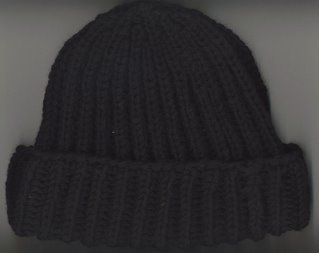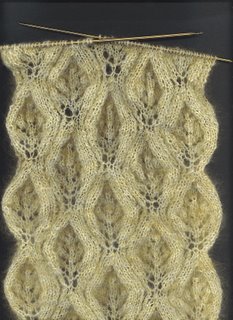
I used to donate hats gloves and mittens to various charities through the Rochester knitting guild. The organizations that received these donations were always very grateful, but usually added a shy request, "The colorful hats you ladies knit are really very nice, but our male clients would really like just plain black." Every year I try to do at least one of these to donate. I always use superwash wool, because I know from my own experience walking around Buffalo in winter that wool is way warmer than acrylic, and I'm guessing that someone who's situation is less than ideal is pretty unlikely to be able to handwash their hat, mittens, etc. I love the technology of machine washable (superwash) wool, and can't understand why so few of my local yarn shops stock it.
The hat is a basic watch cap knit in brioche stitch. Usually brioche is knit flat, which is what was done in the original pattern I used, but I hate putting seams places where they're not needed, and in the case of a hat, the seam usually shows when the bottom is turned up. It's a little tricky to convert brioche to the round because of the odd sort of slip stitch it uses, but luckily someone published a pattern (in interweave knits, I think) in which they had modified it for stitching in the round, so I used their modification and made the hat.
 Each Christmas the Salvation Army makes it possible for businesses and organizations to "adopt" a family whose circumstances have left them unable to afford Christmas presents for each other or a big Christmas dinner. This year the theatre adopted a family with four young children, so a co-worker and I decided to knit mittens for all of them. My two pair are for two boys, ages 3 and 5. I used a free mitten pattern I found at Afghans for Afghans. I like to use my full arsenal of knitting techniques to make each project, even the simple ones, as nicely made and finished as possible. Whenever I make something that starts with ribbing I always "cast on in rib" as I did here, which is why the bottom ribbing sits so nicely and does not flair. I also make sure that my ends are well worked in, especially in something like this which will be going through the washing machine (superwash wool again. I love that stuff!)
Each Christmas the Salvation Army makes it possible for businesses and organizations to "adopt" a family whose circumstances have left them unable to afford Christmas presents for each other or a big Christmas dinner. This year the theatre adopted a family with four young children, so a co-worker and I decided to knit mittens for all of them. My two pair are for two boys, ages 3 and 5. I used a free mitten pattern I found at Afghans for Afghans. I like to use my full arsenal of knitting techniques to make each project, even the simple ones, as nicely made and finished as possible. Whenever I make something that starts with ribbing I always "cast on in rib" as I did here, which is why the bottom ribbing sits so nicely and does not flair. I also make sure that my ends are well worked in, especially in something like this which will be going through the washing machine (superwash wool again. I love that stuff!) My pal Charlie Horse usually just wears a tee shirt, but when I saw him during our freak storm in October, he looked awfully cold, so I knit him a new football sweater. He plays for UB where he is currently a student.
My pal Charlie Horse usually just wears a tee shirt, but when I saw him during our freak storm in October, he looked awfully cold, so I knit him a new football sweater. He plays for UB where he is currently a student. I finished Chris's scarf while we watched Donnie Darko together on his birthday. He has been wearing it constantly since then, although I don't seem to have any photographic proof of that, so you'll just have to take my word for it.
I finished Chris's scarf while we watched Donnie Darko together on his birthday. He has been wearing it constantly since then, although I don't seem to have any photographic proof of that, so you'll just have to take my word for it.  I had gotten a fair amount knitted on my wedding stole before I had to put it down to do the Christmas and birthday knitting. This picture is a great illustration of why blocking is so important, especially with lace. Take a look at how wobbly and dimensional the unblocked knitting is. Also, the lace pattern is hard to make out. Now look back at the second picture in this post. It shows the same lace pattern after blocking. Not only is it flat, but the lace pattern has been opened up so that you can see it clearly. It's also quite a bit larger after blocking. Washing and blocking are what makes a knitted fabric stop acting like a bunch of stitches and start acting like fabric.
I had gotten a fair amount knitted on my wedding stole before I had to put it down to do the Christmas and birthday knitting. This picture is a great illustration of why blocking is so important, especially with lace. Take a look at how wobbly and dimensional the unblocked knitting is. Also, the lace pattern is hard to make out. Now look back at the second picture in this post. It shows the same lace pattern after blocking. Not only is it flat, but the lace pattern has been opened up so that you can see it clearly. It's also quite a bit larger after blocking. Washing and blocking are what makes a knitted fabric stop acting like a bunch of stitches and start acting like fabric.
At the moment I'm working on Mom's red birthday socks, but on the off chance that she looks at the blog before her birthday next month, I won't be posting any pictures of them until after they've been given. All the knitting blogs seem to have that problem right now! Also finished are the tatted snow flakes for this year, which I'll post pictures of after they've been given as gifts for Christmas.
There's a new batch of beer in the fermenter that I can bottle in about a week. I'll be writing about my recent beer adventures in an upcoming blog. The Great Pumpkin Ale will be served with Christmas dinner this year.

No comments:
Post a Comment